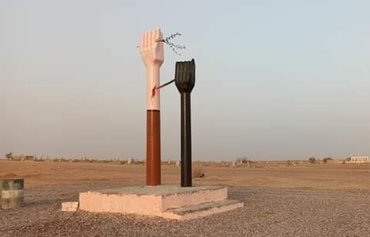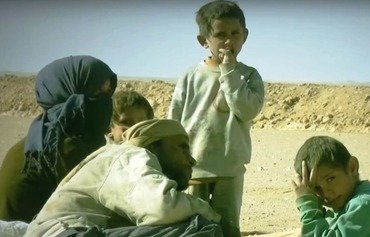The remains of 26 victims of the "Islamic State of Iraq and Syria" (ISIS) have been retrieved from a mass grave in eastern rural Deir Ezzor province.
The victims, all of whom are from al-Shaitat tribe, were killed during a series of violent confrontations with ISIS in August 2014.
They had been buried in a long trench in the desert outside the town of al-Jamma near al-Omar oil field, media activist and al-Shaitat tribesman Sameh al-Akidi told Diyaruna.
Inside the mass grave were the remains of men and youth executed by ISIS during clashes that broke out after the tribe staged an uprising against the group in opposition to its self-proclaimed rule over Deir Ezzor province.
![The remains of ISIS victims are transferred in a convoy from a mass grave to al-Shaitat tribe's cemetery in Deir Ezzor. [Screenshot from Eye of the Euphrates video]](/cnmi_di/images/2020/11/06/26857-shuaytat-syria-grave-600_384.jpg)
The remains of ISIS victims are transferred in a convoy from a mass grave to al-Shaitat tribe's cemetery in Deir Ezzor. [Screenshot from Eye of the Euphrates video]
![Deir Ezzor residents gather at the site of a mass grave containing the remains of tribesmen executed by ISIS near al-Omar oil field. [Photo courtesy of Halab Today TV]](/cnmi_di/images/2020/11/06/26856-grave-shuaytat-syria-600_384.jpg)
Deir Ezzor residents gather at the site of a mass grave containing the remains of tribesmen executed by ISIS near al-Omar oil field. [Photo courtesy of Halab Today TV]
ISIS went on a deadly rampage in response, killing 700 al-Shaitat tribesmen.
Dozens of members of the tribe have still not been accounted for, and remain on missing persons lists. They have not been heard from since ISIS seized control of the area, and their remains have not been found, al-Akidi said.
Many mass graves were dug at random, he said, and finding them will take time, due to the scale of the area where the clashes took place.
After the 2014 violence, fighting between ISIS and the tribesmen continued until 2015, at which time the group issued a decree ordering the killing of all tribesmen over the age of 14 and the confiscation of their property, he said.
Al-Shaitat is one of the largest tribes in the region, and its early rejection of ISIS and uprising against it was pivotal to breaking the group's aura of invincibility, he said.
This explains ISIS's ultra-violent reaction that left about 1,200 victims dead in 2014 and 2015, he said.
Identification of remains
Working with al-Shaitat Martyrs Association, the Autonomous Administration's First Responder Team photographed the remains of the victims, Deir Ezzor media activist Jamil al-Abed told Diyaruna.
They also collected the personal belongings found in their possession.
They then compared the remains and belongings found with them to photographs taken by civilians shortly after the victims were executed.
This resulted in the positive identification of 25 corpses, with only one corpse remaining unidentified, al-Abed said.
"All the victims at this site were men and youth between the ages of 18 and 35," he said, from the families of al-Ahmad, al-Jirou, al-Raheem, al-Radsa, al-Bahr, al-Habib, al-Balo, al-Hanoush, al-Sufi, al-Owaid and al-Mahmoud.
The Martyrs Association co-ordinated with the victims' families after their identification to transfer the bodies to individual graves that had been prepared by the families in al-Shaitat cemetery, he said.
Residents risked their lives
According to Moataz al-Akidi, a resident of rural Deir Ezzor, the grave was not dug by ISIS elements, but rather by the residents of neighbouring villages.
He said they had waited until the ISIS elements withdrew after the executions, and then photographed all the victims before burying them, with the intent of identifying them at a later time through the use of the photographs.
"They did this at great risk to their own safety," al-Akidi said, pointing to the consequences they may have faced if ISIS had found out about their actions.
The remnants of the clothing found at the grave site were compared to the clothes the victims were wearing when they were photographed, which facilitated their identification, he added.
After the grave site was identified on October 26th, the process of identifying the victims was completed in a few days, he said, which saved a lot of time and effort and dispensed with the need for DNA testing.
Even though the certain knowledge that their sons are dead has brought the families great pain, it also gave them closure, he said.

![Volunteers and local residents uncover the remains of ISIS victims at a newly-discovered mass grave in Deir Ezzor. [Screenshot from North Press video]](/cnmi_di/images/2020/11/06/26858-syrians-open-grave-600_384.jpg)






